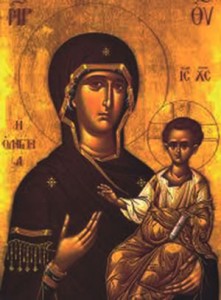Mary for the Third Millennium: Prayer. (6)
The Hail Mary: Being faithful to the people of today and being faithful to the tradition means acquiring a balance between the old and the new. In a recent article on Mary and Ecumenism, I quoted Zwingli, the Swiss Reformer: “The Ave Maria is not a prayer, but a greeting and a praise” – the greeting of the archangel Gabriel at the annunciation and of Elizabeth at the visitation. He assumed that good Catholics are in the habit of praying the Hail Mary, though he knew only the scriptural first part of the prayer without its later addition. At that point I thought to myself sometime I must find when and from where did the second part of the Hail Mary arrive?
Being faithful to the people of today and being faithful to the tradition means acquiring a balance between the old and the new.
The Catholic Encyclopaedia tells us that there is little or no trace of the Hail Mary as an accepted devotional formula before about 1050, though a later pious tale attributed to Ildephonsus of Toledo (7th century) the use of the first part, namely the angel’s greeting of Mary, without that of Elizabeth, as a prayer. To the greeting and praise of Mary of which the prayer consisted, a petition “Holy Mary, Mother of God, pray for us sinners now and at the hour of our death. Amen,” was added later. The petition first appeared in print in 1495 in Girolamo Savonarola. The petition was commonly added around the time of the Council of Trent. The Dutch Jesuit St. Peter Canisius is credited with adding in 1555 in his Catechism the sentence: Holy Mary, Mother of God, pray for us sinners.
Eleven years later, the sentence was included in the Catechism of the Council of Trent of 1566. The “Catechism of the Council of Trent” says that to the first part of the Hail Mary, by which “we render to God the highest praise and return Him most gracious thanks, because He has bestowed all His heavenly gifts on the most holy Virgin ... the Church of God has wisely added prayers and an invocation addressed to the most holy Mother of God ... we should earnestly implore her help and assistance; for that she possesses exalted merits with God, and that she is most desirous to assist us by her prayers, no one can doubt without impiety and wickedness.”
Hail Holy Queen (Salve Regina). The work was composed during the Middle Ages by German monk Hermann of Reichenau (1013-1054) and originally appeared in Latin, the prevalent language of Western Christianity until modern times. Traditionally it has been sung in Latin, though many translations exist. These are often used as spoken prayers. Hermann of Reichenau, also called Herman the Cripple, was an 11th-century scholar, composer, music theorist, mathematician, and astronomer. His life was one of great pain, lending poignancy to the lines of the prayer: To thee do we cry, poor banished children of Eve, to thee do we send up our sighs, mourning and weeping in this valley, of tears. He was crippled by a paralytic disease from early childhood. He was born with a cleft palate, cerebral palsy and is said to have had spina bifida. As a result, he had great difficulty moving and could hardly speak. At seven, he was placed in a Benedictine monastery by his parents who could no longer look after him.
He also composed the Marian prayer Alma Redemptoris Mater (see below). He was beatified in 1863.
Loving Mother of the Redeemer,
gate of heaven, star of the sea,
assist your people who have fallen yet strive to rise again.
To the wonderment of nature you
bore your Creator,
yet remained a virgin after as before.
You who received Gabriel’s joyful greeting,
have pity on us poor sinners.
You will detect several references that lead towards the Angelus in this prayer.
The Angelus. This prayer has its focus on the Incarnation of Jesus: The angel of the Lord declared unto Mary. Three verses and responses describe the mystery and three Hail Marys honour Mary for her Yes. It has traditionally been prayed in churches and monasteries at 6 a.m., 12 noon, and 6 p.m. It has ecumenical significance as it is prayed in some Lutheran and Anglican churches. Often it is accompanied by the ringing of bells as a call to prayer and expression of good will to all on earth, in the spirit of the angelic message to the shepherds. The angel in the first verse is Gabriel, the messenger of God who revealed to Mary that she would conceive a child to be born the Son of God. (Luke 1:26-38). The prayer evolved from a recitation of three Hail Mary’s following an evening bell around the 12th century to its present form (with morning and midday recitations) in the 16th century.
We Fly to Your Patronage (Sub tuum).
We fly to thy patronage, O holy Mother of God; despise not our petitions in our necessities, but deliver us always from all dangers, O glorious and blessed Virgin. Amen.
This ancient prayer to the Blessed Virgin is probably the oldest known one. The earliest text of this hymn was found in a Coptic Orthodox Christmas liturgy of the third century. It is written in Greek and dates to approximately 250. The prayer is a strong part of Marist spirituality because it was a Sulpician custom that all classes ended with a recitation of this prayer. Sulpician priests provided the seminary formation in France notably the major seminary of St Irenaeus attended by St Jean-Marie Vianney, the Cure′ of Ars, Jean-Claude Colin, founder of the Marist Fathers, and St Marcellin Champagnat, founder of the Marist Brothers.
“Indeed from most ancient times the Blessed Virgin has been venerated under the title of ‘God-bearer’. In all perils and difficulties the faithful have fled prayerfully to her protection.” (LG, 8:66). This is the first time a prayer to Our Lady expresses belief in her powers of intercession, applying to her the word ‘deliver’ from the “Our Father,” deliver us from evil (Mt 6:13). The text contains the word “Theotokos”, addressing Mary as ‘holy Mother of God’, the title which was to provoke so much controversy at the council of Ephesus (431).
Memorare. Remember, O most gracious Virgin Mary, that never was it known that anyone who fled to your protection, implored your help, or sought your intercession, was left unaided. Inspired with this confidence, I fly to you, O Virgin of virgins, my Mother. To you I come, before you I stand, sinful and sorrowful. O Mother of the Word Incarnate, despise not my petitions, but in your mercy, hear and answer me. Amen.
From the Latin “Remember”, is frequently misattributed to the 12th-century Cistercian monk Saint Bernard of Clairvaux, apparently due to confusion with its 17th-century Father Claude Bernard (1588-1641), who stated that he learned it from his own father. Father Claude Bernard was a French Roman Catholic priest who was primarily active in ministry to prisoners and criminals, especially those condemned to death. He is primarily remembered as the populariser of the Memorare, of which he distributed more than 200,000 leaflets printed in various languages. He claimed in a letter to Queen Anne of Austria, wife of King Louis XIII of France, that he had himself been miraculously cured of illness through intercession of the Blessed Virgin Mary as a result of his reciting the prayer.
Conclusion
Reflecting on these prayers, we see three major types, invocation, praise, and remembrance. Not all prayers to Mary have the same function. Prayers of invocation directly call upon her for help as such a prominent member of the communion of saints. Those prayers that recall her memory or praise her, plunge us into the mystery of the Church and bring us to the source of all prayer, the praise of a deeply loving God who gives everything freely. Mary’s Yes and her involvement in the mystery of God’s plan, which includes her in the Church, means that invocation, praise and remembrance remain forever useful in our prayer life. Doctrine and devotion, Bible and Church, Mary and Jesus – like prayer itself, an unending journey into God.
References: Catholic Encyclopaedia.
Prevost, Jean-Pierre. (1988). Mother of Jesus. Novalis:Ottawa.



 Entries(RSS)
Entries(RSS)
You are truly a excellent webmaster. The web site loading pace is incredible. It sort of feels that you're doing any unique trick. Furthermore, The contents are masterpiece. you have done a magnificent task on this topic!